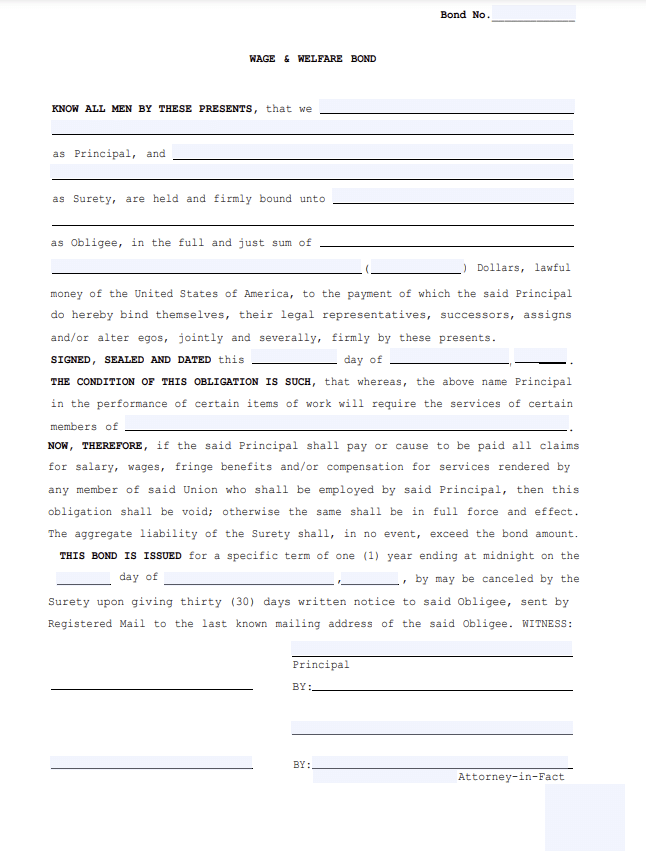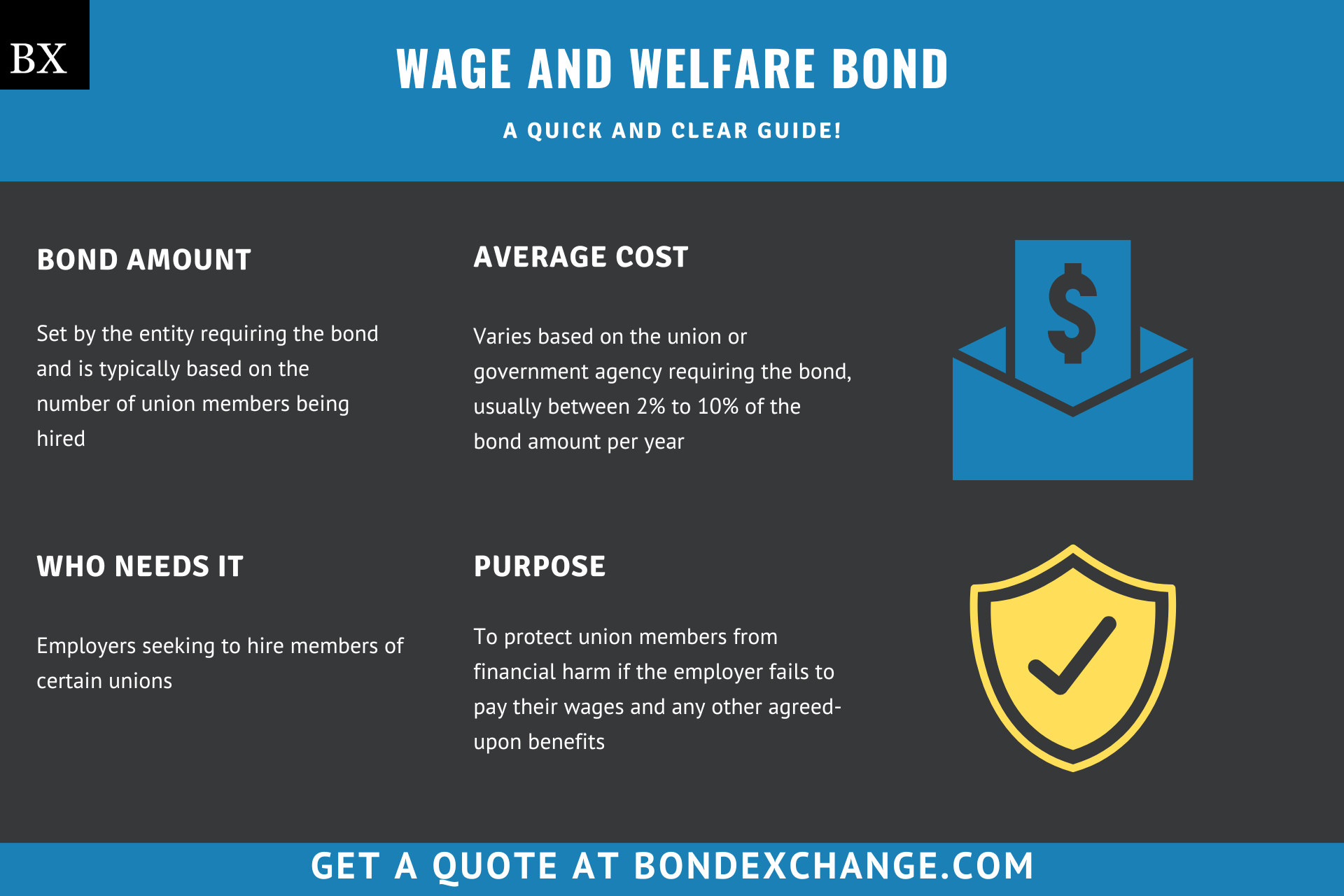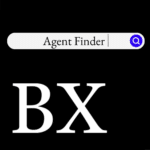Wage and Welfare Bond: A Comprehensive Guide
This guide provides information for insurance agents to help their customers obtain a Wage and Welfare bond.
At a Glance:
- Average Cost: Varies based on the union or government agency requiring the bond, usually between 2% to 10% of the bond amount per year
- Bond Amount: Set by the entity requiring the bond and is typically based on the number of union members being hired
- Who Needs it: Employers seeking to hire members of union certain unions
- Purpose: To protect union members from financial harm if the employer fails to pay their wages and any other agreed-upon benefits
- Who Requires Wage and Welfare Bonds: Mostly unions, however, a few state government agencies do so as well

What is a Wage and Welfare Bond?
Wage and Welfare bonds, sometimes called union or fringe benefit bonds, are surety bonds required of employers when hiring members of a union. Wage and welfare bonds protect members of a union from losses if their employer does not provide all agreed-upon compensation and benefits.
For example: Imagine a railway company that is looking to hire more signalmen. The workers the company wants to hire are all part of a union, which requires the railway company to purchase a Wage and Welfare bond before their members begin work. If the railway company fails to pay any wages or fringe benefits, the union members can file a claim against the company’s bond to recoup their losses.
Unlike most insurance products, Wage and Welfare bonds protect a third party (the union members) for acts that violate a collective agreement. When the surety company suffers a loss due to the employer’s actions, the principal must repay to the surety company any losses and sometimes court costs and other fees.
Who Needs a Wage and Welfare Bond?
As mentioned above, employers that hire union members may need to purchase a Wage and Welfare bond. The decision of if and when to require a bond lies with individual unions, who are also able to dictate the bond’s terms and conditions.
How Can an Insurance Agent Obtain a Wage and Welfare Surety Bond?
BondExchange makes obtaining a Wage and Welfare bond easy. Simply log in to your account and use our keyword search to find the “wage and welfare” bond in our database. Don’t have a login? Gain access now and let us help you satisfy your customers’ needs. Our friendly underwriting staff is available by phone at (800) 438-1162, email, or chat from 7:30 AM to 7:00 PM EST to assist you.
At BondExchange, our 40 years of experience, leading technology, and access to markets ensures that we have the knowledge and resources to provide your clients with fast and friendly service whether obtaining quotes or issuing bonds.
Not an agent? Then let us pair you with one!
Click the above image to find a BX Agent near you
Who Regulates Wage and Welfare Bonds?
The vast majority of Wage and Welfare bonds are not required by a government agency but by individual unions. However, certain state government agencies do have Wage and Welfare bond requirements. For example, the West Virginia Wage Payment and Collection Act dictates that the West Virginia Department of Labor must require employers in certain industries to purchase a Wage and Welfare bond. Additionally, the New York Department of State requires salons that employ at least two full-time employees that provide nail specialty services to obtain a Wage and Welfare bond.
What is the Bond Amount for Wage and Welfare Bonds?
The required amount for a Wage and Welfare bond is determined by the union or government agency requiring it. With that being said, most Wage and Welfare bond amounts will be either $25,000 or $50,000. However, certain unions have a tiered structure to determine the required bond amount based on the number of union members being hired.
What are the Underwriting Requirements for a Wage and Welfare Bond?
Wage and Welfare bonds are considered risky by surety companies. As such, surety companies will typically run your customers’ credit and examine their business and personal financial statements. Most carriers use a “soft check”, so the credit review will not affect your customer’s credit. Additionally, your customers may be required to put up collateral before being issued their bond.
How Much Does a Wage and Welfare Bond Cost?
A Wage and Welfare bond will generally cost between 2% to 10% of the bond amount per year. Applicants with the best credit and financial statements can expect to pay the lowest rates, while applicants with poor credit and financials will pay higher rates. The chart below offers a quick reference for the approximate cost of a $50,000 Wage and Welfare bond
$50,000 Wage and Welfare Bond Cost Sample
| Credit Score* | Bond Cost (1 Year) | Bond Cost (1 month) |
|---|---|---|
| 800+ | $1,000 | $100 |
| 680 – 799 | $1,876 | $188 |
| 650 – 679 | $2,500 | $250 |
| 600 – 649 | $3,750 | $375 |
| 550 – 599 | $5,000 | $500 |
*The credit score ranges do not include other factors that may result in a change to the annual premium offered to your customers, including but not limited to, years of experience and underlying credit factors contained within the business owner’s credit report.

What Information is Collected for Wage and Welfare Bond Application?
Surety company underwriters will collect and review the following information to determine eligibility for a Wage and Welfare bond:
- Legal name of the applicant
- Business name
- Address, phone number, and email address
- Social security number
- Business and personal financial statements
- Number of union employees being hired
How Do Employers File Their Wage and Welfare Bonds?
Surety bond companies will provide your customer with a completed surety bond to be filed with the relevant union or government agency. The surety bond requires signatures from both the surety company that issues the bond and from your customer. In some instances, the bond will require witness signatures as well. Generally, the surety company will include the following information on the bond form:
- Name and address of entity/individual(s) buying the bond
- Surety company’s name and address
- Entity requiring the bond
- Bond amount
- Date the bond is signed
- Date the bond goes into effect
What Can Your Customers Do to Avoid Claims Against a Wage and Welfare Bond?
To avoid claims on a Wage and Welfare bond, your customers must ensure they honor the terms of any collective agreement and pay all wages and fringe benefits owed.
Which Unions and Government Agencies Require a Wage and Welfare Bond?
Click the below button for a complete list unions and government agencies that require employers to purchase a Wage and Welfare Bond:

